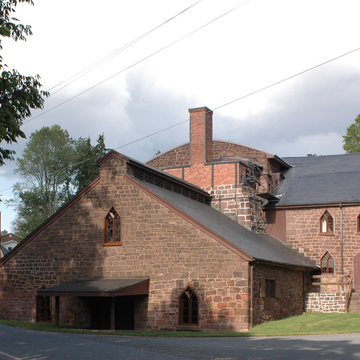The centerpiece of the Cornwall Iron Works is the oddly rustic furnace with pointed Gothic windows set in carefully cut brownstone walls, as if Hobbits had tried their hand at the industrial culture that J. R. R. Tolkien disdained. The Cornwall furnace may well have been the source for much of the architectural character of Henry Mercer's museum in Doylestown (BU43). Buildings were erected on the site
You are here
Cornwall Iron Furnace, Cast House, Bridge House, and Engine House
c. 1739–1742; 1846 rebuilt; 1856–1857. Boyd St. and Rexmont Rd.
If SAH Archipedia has been useful to you, please consider supporting it.
SAH Archipedia tells the story of the United States through its buildings, landscapes, and cities. This freely available resource empowers the public with authoritative knowledge that deepens their understanding and appreciation of the built environment. But the Society of Architectural Historians, which created SAH Archipedia with University of Virginia Press, needs your support to maintain the high-caliber research, writing, photography, cartography, editing, design, and programming that make SAH Archipedia a trusted online resource available to all who value the history of place, heritage tourism, and learning.


